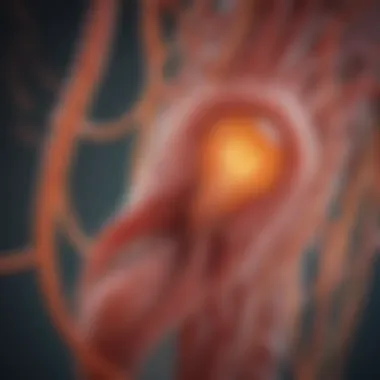Understanding HSP IgA Nephropathy: Insights and Advances


Intro
HSP IgA nephropathy is a specific type of renal disorder that arises due to the deposition of immunoglobulin A (IgA) in the glomeruli. This autoimmune condition primarily affects young individuals but can be observed across different age groups. Understanding the mechanisms behind the disease is essential for developing effective diagnostic and therapeutic strategies. The complexity of the disease presents challenges not only for diagnosis but also for ongoing management. This article aims to provide a comprehensive overview, highlighting the significant aspects of HSP IgA nephropathy.
Key Findings
Major Results
The research on HSP IgA nephropathy has demonstrated several crucial insights:
- Incidence and Prevalence: The condition is more prevalent in certain regions, particularly in East Asian populations.
- Pathophysiology: IgA deposition triggers immune responses, leading to inflammation and kidney dysfunction.
- Symptoms: Patients may present with hematuria, proteinuria, and hypertension. Early identification of these symptoms is critical for effective management.
Discussion of Findings
The findings indicate that while HSP IgA nephropathy is often treated with corticosteroids and immunosuppressants, recent studies suggest that individualized treatment plans may yield better outcomes. Understanding the genetic and environmental factors that influence disease progression can help tailor these approaches. Additionally, advances in biomarker identification may improve early diagnosis and monitoring, particularly in cases where traditional methods fall short.
Methodology
Research Design
A mixed-methods approach has been employed in recent studies. Quantitative data from patient cohorts alongside qualitative interviews shed light on the patient experience and treatment outcomes. Such an approach helps in drawing comprehensive conclusions about the disease pathology.
Data Collection Methods
- Patient Records: Analysis of clinical records provides a solid foundation for understanding incidence and treatment efficacy.
- Surveys and Interviews: Engaging with patients aids in understanding the subjective impact of the disease and the effectiveness of various treatment modalities.
Effective management of HSP IgA nephropathy requires a nuanced understanding of both biological and personal factors influencing the disease.
Continued research is vital to address the gaps in knowledge and improve patient outcomes. Our understanding of the interplay between genetics, environmental triggers, and immune responses is crucial in developing targeted therapies for this complex renal disorder.
Throughout this article, we will delve deeper into these aspects to provide a clear picture of HSP IgA nephropathy and its implications for patient care.
Understanding HSP IgA Nephropathy
Understanding HSP IgA nephropathy is crucial for healthcare professionals involved in nephrology, pediatrics, and immunology. The disease, also known as Henoch-Schönlein purpura nephritis, represents a common cause of glomerulonephritis in children and can also affect adults. This section aims to clarify its significance, complexities, and implications in clinical practice.
Recognizing the characteristics of HSP IgA nephropathy allows for prompt diagnosis and management, which can prevent long-term complications, such as chronic kidney disease. The knowledge of this condition is essential in developing effective treatment plans. Furthermore, understanding the epidemiology helps identify at-risk populations and informs patient education strategies.
Defining HSP IgA Nephropathy
HSP IgA nephropathy is characterized by the deposition of IgA-containing immune complexes in the kidneys. This condition often follows an upper respiratory infection or gastroenteritis, initiating an immune response that targets the vascular lining of the kidneys. Clinically, it presents with symptoms such as hematuria and proteinuria, which may lead to nephritic syndrome. Understanding how this disease manifests is critical for distinguishing it from other forms of nephritis.
Etiology and Risk Factors
The etiology of HSP IgA nephropathy is multifactorial, involving genetic, environmental, and immunological components. Family history plays a role, suggesting a hereditary predisposition. Recent studies imply that environmental triggers, including viral infections, could precipitate the condition in genetically susceptible individuals. Other risk factors include:
- Recent infections: Viral or bacterial infections may contribute to the onset.
- Age: Most commonly seen in children ages 2-11.
- Seasonality: Higher prevalence during colder months. Understanding these risk factors is essential in identifying individuals likely to develop this illness, thereby guiding preventative measures.
Pathophysiological Mechanisms


The pathophysiology of HSP IgA nephropathy involves dysregulation of the immune system, leading to abnormal IgA production. This hyperproduction results in the formation of immune complexes that deposit in the glomeruli, causing an inflammatory response. Key mechanisms involved include:
- Complement activation: The classical pathway can be triggered by immune complexes, leading to glomerular injury.
- Cytokine release: Pro-inflammatory cytokines exacerbate kidney inflammation and damage.
- Podocyte dysfunction: Injury to podocytes can disrupt the filtration barrier, contributing to proteinuria.
Through these mechanisms, acute and chronic renal impairment may develop, highlighting the importance of understanding them for effective therapeutic interventions.
Clinical Features of HSP IgA Nephropathy
Understanding the clinical features of HSP IgA nephropathy is crucial for accurate diagnosis and effective management. The manifestations of this condition can vary widely, and recognizing these symptoms can greatly enhance patient care. It is essential for healthcare professionals to be aware of these features to ensure timely intervention and tailored treatment strategies. The clinical presentation not only aids in diagnosis but also influences prognosis, making it a vital aspect of patient management.
Common Symptoms and Signs
HSP IgA nephropathy often presents with a range of symptoms that can differ among patients. Some of the most common signs include:
- Hematuria: This is the presence of blood in the urine, which can be microscopic or visible. It is often one of the first indicators that prompts further investigation.
- Proteinuria: Increased protein levels in the urine are also noticeable and can be determined through laboratory tests. This condition often indicates renal impairment.
- Hypertension: High blood pressure may develop due to kidney dysfunction. Monitoring blood pressure is crucial in patients with HSP IgA nephropathy.
- Edema: Swelling of the legs, ankles, or face can occur, particularly in cases where kidney function declines significantly.
In addition to these primary symptoms, patients might experience fatigue, weakness, and flank pain. Understanding these signs helps healthcare professionals distinguish HSP IgA nephropathy from other kidney-related diseases.
Complications and Prognosis
The prognosis of HSP IgA nephropathy can vary widely based on clinical features. Several complications can arise, impacting long-term outcomes. Key considerations include:
- Progressive Renal Failure: Some patients may experience a gradual decline in kidney function, potentially leading to end-stage renal disease. Early detection and intervention can slow progression.
- Glomerular Disease: The patient may develop additional kidney complications, such as glomerulosclerosis, if HSP IgA nephropathy goes untreated or is poorly managed.
- Cardiovascular Disease: Patients with hypertension or kidney disease are at a higher risk for developing cardiovascular issues. Careful management of blood pressure and overall health is essential.
Overall prognosis is variable. Factors like age, severity of symptoms, and response to treatment all contribute. Regular follow-up and monitoring are necessary to assess kidney function and adapt treatment as needed.
"Early recognition of the clinical features of HSP IgA nephropathy can significantly improve patient outcomes through timely intervention."
Diagnostic Approaches
The diagnostic approaches for HSP IgA nephropathy hold significant importance in understanding the condition and enabling effective management. Accurate diagnosis allows healthcare professionals to tailor treatment strategies that match the individual needs of patients. This section covers various components essential to the diagnostic process, including clinical evaluations, laboratory investigations, imaging techniques, and the critical role of kidney biopsy and histopathology.
Clinical Evaluation
Clinical evaluation serves as the first step in diagnosing HSP IgA nephropathy. Physicians often begin by obtaining a detailed medical history. They typically ask about recent infections, as upper respiratory tract infections may often precede the onset of symptoms. A thorough physical examination is crucial to identifying signs of renal impairment. Patients may present with hematuria, proteinuria, and even hypertension. Each of these symptoms provides valuable information that aids in reaching a diagnosis.
Practitioners should remain observant for risk factors, including age and ethnicity, which can influence disease presentation and progression. The integration of clinical evaluation and patient history leads to a more coherent picture, guiding further investigations.
Laboratory Investigations
Laboratory investigations play an essential role in confirming a diagnosis of HSP IgA nephropathy. A urinalysis is often a starting point. This test can reveal the presence of red blood cells and protein, indicating possible kidney damage. Generally, the main findings include the detection of IgA deposits in kidney tissue. Additionally, blood tests might be needed to assess renal function and check for elevated creatinine levels.
Serological tests may also be warranted to evaluate for any underlying immune conditions. These investigations guide the clinician in determining the severity of the disease and the most suitable treatment plan.
Imaging Techniques
Imaging techniques add another layer of insight when diagnosing HSP IgA nephropathy. While not always necessary, ultrasound imaging can help assess kidney size and detect structural abnormalities. Invasive imaging studies, such as CT scans or MRIs, are rarely indicated unless complications such as obstruction or malignancy are suspected. However, these modalities can enhance the diagnostic process, providing visual confirmation that complements other assessments.
Kidney Biopsy and Histopathology


A kidney biopsy remains the gold standard for definitive diagnosis and understanding the histopathological features of HSP IgA nephropathy. During this procedure, small samples of kidney tissue are obtained for examination under a microscope. Pathologists specifically look for the characteristic IgA deposition in the mesangial areas of the kidney. The findings can indicate the severity of the lesion and guide treatment decisions.
"A kidney biopsy is integral not only for diagnosis but also for assessing the patient's prognosis and potential response to treatment."
The histopathological examination may also reveal other changes that include mesangial expansion or endocapillary proliferation. Recognizing these features provides insight into the evolving nature of the disease, allowing clinicians to adapt their management accordingly.
In summary, the combined forces of clinical evaluation, laboratory investigations, imaging techniques, and kidney biopsy create a comprehensive approach that enables accurate diagnosis of HSP IgA nephropathy. The timely identification of this disorder facilitates appropriate interventions, significantly impacting patient outcomes.
Treatment Strategies
In the management of HSP IgA nephropathy, understanding the treatment strategies is crucial. This aspect significantly influences patient outcomes and the progression of kidney disease. Effective treatment not only addresses symptoms but also aims to prevent further complications. Patients with HSP IgA nephropathy often require a multifactorial approach, combining both conventional and emerging therapies. Decision-making requires careful consideration of the individual patient's condition, disease severity, and response to prior treatment.
Conventional Therapies
Conventional therapies for HSP IgA nephropathy commonly include medications aimed at controlling symptoms and preventing deterioration of kidney function. The mainstays often comprise:
- Corticosteroids: Corticosteroids like prednisone are frequently used to reduce inflammation in the kidneys. While their usage is somewhat contentious due to potential side effects, some studies suggest that they may be beneficial for patients with significant proteinuria.
- Angiotensin Converting Enzyme (ACE) Inhibitors: These agents can help lower blood pressure and reduce proteinuria. Examples include lisinopril and ramipril. Control of hypertension is crucial, as high blood pressure can worsen renal function.
- Immunosuppressive Therapy: In more severe cases, treatments such as azathioprine or mycophenolate mofetil may be considered. They work by dampening the immune response that contributes to kidney injury.
Each conventional therapy brings its own profile of benefits and potential risks. Monitoring patients closely is vital to appropriately adjust the treatment based on their response.
Emerging Treatments
Research is uncovering new approaches to treat HSP IgA nephropathy that go beyond traditional methods. Emerging treatments focus on targeting specific aspects of the disease pathology. Some of the notable advances include:
- Biological Agents: Newer agents like rituximab, which targets B cells, have shown promise in various nephropathies and are being investigated for HSP IgA nephropathy.
- Complement Inhibitors: These target the complementary system which can be overactivated in some patients. Their role in IgA nephropathy is being explored in clinical settings.
- Sodium-Glucose Cotransporter-2 (SGLT2) Inhibitors: Medications like empagliflozin may help manage proteinuria and kidney function, and their utility in HSP IgA nephropathy is the subject of evolving research.
This landscape of emerging therapies highlights the necessity of ongoing research to ascertain their efficacy and safety for specific patient populations.
Patient Management Approaches
Effective patient management encompasses a comprehensive approach to care that goes beyond pharmacological treatment. This includes educating patients about their condition, monitoring disease progression, and ensuring support systems are in place. Key aspects of patient management include:
- Regular Monitoring: Frequent assessments of kidney function, protein levels, and blood pressure are fundamental. Regular follow-ups can detect changes early and adjust treatment accordingly.
- Lifestyle Modifications: Advising patients on dietary changes, such as reducing sodium intake, can help manage hypertension. Encouragement of physical activity within tolerable limits is also beneficial.
- Psychosocial Support: Providing mental health resources and support groups can help patients cope with the chronic nature of the disease and improve their quality of life.
Overall, a multidimensional approach to treatment and management can empower patients, optimize clinical outcomes, and potentially slow disease progression.
"The complexity of HSP IgA nephropathy necessitates a tailored approach in treatment strategies, emphasizing personalized care to enhance the patient journey."
Following advancements in research and treatment approaches will remain essential in addressing the evolving challenges that HSP IgA nephropathy presents.
Recent Research and Developments
Research in HSP IgA nephropathy represents an essential avenue for understanding the complexities of this renal disorder. The developments in this area not only help in unraveling the pathophysiological mechanisms but also enhance patient management approaches. New findings can influence treatment strategies and improve outcomes. Therefore, staying abreast of this research is crucial for healthcare professionals involved in the care of patients.
Clinical Trials Overview
Current clinical trials focus on various treatment modalities and intervention strategies for HSP IgA nephropathy. These trials aim to evaluate the effectiveness of existing therapies and to discover new treatment opportunities. For instance, studies involving immunosuppressants and their roles in managing renal function are ongoing. Furthermore, trials assessing the impact of dietary modifications and lifestyle changes provide insights into holistic management.
Relevant information from these clinical trials can guide clinical decision-making and improve patient outcomes. It is vital to monitor the progress of these trials through resources like clinicaltrials.gov or peer-reviewed journals.


Genetic and Environmental Studies
Understanding the genetic and environmental factors that contribute to HSP IgA nephropathy is key to advancing treatment options. Recent studies have explored gene polymorphisms linked to immune response and their association with the risk of developing the disease. Moreover, environmental factors, such as infections and dietary habits, are also under scrutiny. These elements may play a significant role in the pathogenesis of the disease.
Furthermore, identifying biomarkers for early detection remains a priority. Progress in genetic studies allows researchers to comprehend how specific genes influence disease severity. Such information can lead to more personalized approaches in treatment.
Future Directions in Research
Future research suggests focusing on a multi-disciplinary approach involving genetics, immunology, and nephrology. Collaborations among various fields may yield breakthroughs in understanding HSP IgA nephropathy. New therapeutic targets, including biological agents, warrant exploration to address the limitations of current treatments.
The utilization of advanced technologies, such as CRISPR-Cas9 gene editing, might offer opportunities for innovative treatment strategies. Therefore, ongoing research must prioritize understanding the disease's underlying mechanisms to enhance therapeutic interventions. The potential for improved patient care and outcomes hinges on these advancements.
"Through continuous research and collaboration, we pave the way for effective management of HSP IgA nephropathy, ultimately improving patients' lives."
Implications for Healthcare Professionals
The management of HSP IgA nephropathy is intricately tied to effective strategies employed by healthcare professionals. This renal disorder, characterized by its complex pathophysiology and fluctuating clinical course, necessitates a thorough understanding among practitioners from various specialties. The implications extend to inter-professional collaboration and the need for robust patient education and support.
Interdisciplinary Collaboration
Addressing HSP IgA nephropathy effectively involves an interdisciplinary approach. Nephrologists play a crucial role in diagnosis and treatment plans, while pediatricians may manage cases in younger patients. Furthermore, dietitians contribute significantly, especially in dietary adjustments to minimize progression of kidney damage.
For healthcare teams, established communication pathways can facilitate continuity of care. Regular meetings involving nephrologists, dietitians, psychologists, and primary care physicians can refine treatment strategies, ensuring they are tailored to meet individual patient needs.
Additionally, sharing insights and ongoing research findings among differing healthcare professionals maintains a high standard of clinical practice.
"The complexity of HSP IgA nephropathy demands a collaborative approach to ensure that all aspects of a patient’s health are considered."
Patient Education and Support
Patient education is vital in managing HSP IgA nephropathy. Understanding the nature of the disease allows patients and their families to engage actively in their care. Clear communication from healthcare providers can empower patients, enhancing their adherence to treatment protocols.
Support networks should be in place to assist patients through their journey. Providing resources, such as literature about the disease and facilitating support groups, fosters a community where patients can share experiences and learn from each other. This aspect of care is often underestimated but plays a significant role in achieving better health outcomes.
Overall, the implications for healthcare professionals are profound. Understanding the dynamics of HSP IgA nephropathy is not only beneficial for clinical practice but also enhances the patient experience. Emphasizing interdisciplinary collaboration and thorough patient education will undoubtedly lead to more successful management outcomes.
Closure
The conclusion plays a critical role in this article by synthesizing the key points discussed, reinforcing the understanding of HSP IgA nephropathy, and demonstrating its complexities. Summarizing the intricate relationship between the pathophysiology, clinical features, diagnosis, and treatments not only aids in comprehension but also helps emphasize the relevance for practitioners and researchers. This section serves as a reminder of the multifaceted nature of the disease and the importance of a holistic approach in patient management.
Furthermore, it underscores the ongoing challenges that healthcare professionals face in treating HSP IgA nephropathy, highlighting the need for effective interdisciplinary collaboration. Through a well-rounded conclusion, readers are equipped with an understanding of the essential aspects of HSP IgA nephropathy, thus empowering them to make informed decisions in practice and research.
Summary of Key Concepts
In summarizing the key concepts presented throughout the article, several major points should be highlighted:
- Defining HSP IgA Nephropathy: This condition is characterized by the deposition of immunoglobulin A in the kidney, leading to varied renal impairments.
- Clinical Presentation: Symptoms can range from mild hematuria and proteinuria to severe manifestations, including renal failure.
- Diagnosis: Employing a comprehensive diagnostic approach is crucial, encompassing clinical evaluation, laboratory tests, imaging, and, importantly, kidney biopsy.
- Treatment Options: The management strategy often requires a combination of conventional therapies and emerging treatment modalities.
- Recent Research: Ongoing studies are crucial for unraveling the complexities of the disease, assessing novel treatments, and understanding genetic influences on susceptibility.
These points collectively enhance the reader's grasp of the topic, bridging theoretical knowledge and practical implications.
Call for Ongoing Research and Innovation
The imperative for ongoing research and innovation in HSP IgA nephropathy cannot be overstated. This renal disorder is still burdened with many uncertainties regarding its etiology and optimal management approaches.
- Novel Therapeutics: Increased focus on developing targeted therapies could significantly improve patient outcomes.
- Genetic Studies: Investigating genetic predispositions may help identify at-risk populations, facilitating early interventions.
- Longitudinal Studies: Such studies could provide valuable insights into disease progression and long-term consequences, further driving new approaches to patient care.



